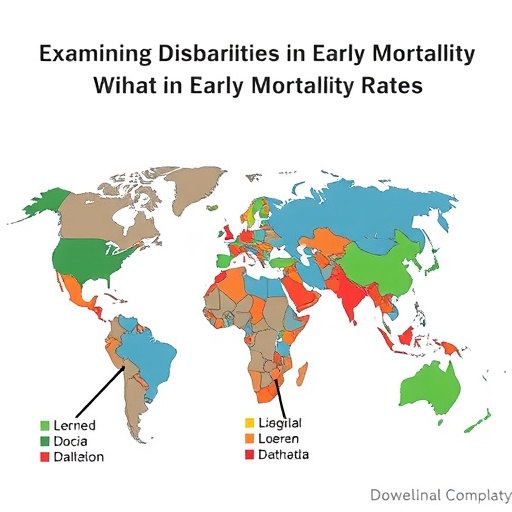In the contemporary landscape of public health, there exists an urgent need to address the growing disparities in mortality rates among different populations. A recent cross-sectional study highlights the probability of premature death, which is defined as dying before reaching the age of 70. This statistic serves as a critical indicator of health inequalities and exposes underlying issues related to access to healthcare and socio-economic factors influencing life expectancy. The findings of this study call out for immediate attention from policymakers, healthcare providers, and researchers alike, emphasizing the need for equitable dissemination of health-enhancing technologies.
The concept of premature death is not merely a statistic but a reflection of the disparities faced by various demographic groups. It encompasses a multitude of factors, including socio-economic status, geographic location, and access to healthcare technologies. In this study, researchers found that those living in underprivileged areas are disproportionately affected, highlighting a significant gap in health outcomes that can be traced to systemic inequalities. The urgency of this matter beckons a reevaluation of how resources are allocated and the strategies employed to promote health equity.
As technological advancements in medicine progress at an unprecedented rate, the sheer volume of innovations has not translated into equal health benefits across populations. The study emphasizes that while groundbreaking treatments and health-enhancing technologies are being developed, their rapid and fair dissemination is often hindered by existing infrastructural and systemic barriers. This discrepancy raises ethical concerns about the availability and accessibility of life-saving treatments, particularly for marginalized communities that continue to face significant health challenges.
Moreover, the study posits that context-specific obstacles should not be overlooked. Social determinants of health, including education, income levels, and community safety, play a pivotal role in influencing not just the quality of healthcare one can receive, but also the likelihood of achieving a longer, healthier life. This suggests that solutions aimed at reducing health disparities must encompass not only improving healthcare access but also tackling the broader socio-economic challenges that contribute to these inequities.
In light of these findings, researchers argue for a comprehensive approach to health policy reform that prioritizes equal treatment access and addresses the social determinants of health. Such reforms could involve increasing funding for healthcare in disadvantaged regions, implementing outreach programs to educate communities about available health resources, and ensuring that advancements in medical technology are not confined to affluent populations. The overall goal should be to create a level playing field where all individuals, regardless of socioeconomic status, can lead healthy lives and achieve their full potential.
Addressing health disparities also requires collaboration among various stakeholders, including government agencies, non-profit organizations, healthcare providers, and the communities themselves. This collective approach ensures that solutions are not only developed but also effectively implemented, monitored, and adjusted as necessary. The study serves as a call to action for these groups to unite in addressing the root causes of health inequities.
Furthermore, the dissemination of health-related information is vital in empowering individuals to take an active role in their health and well-being. The study suggests that ensuring access to clear, accurate, and accessible health information can significantly enhance community engagement and awareness about available health services. This proactive stance can lead to greater utilization of healthcare resources, ultimately contributing to reduced mortality rates.
In addition to enhancing community health literacy, investment in preventive care is critical for bridging the gap in health disparities. The study advocates for policies that emphasize preventive health measures, including vaccination, screening programs, and education on healthy lifestyle choices. By focusing on prevention, the burden of disease can be significantly reduced, leading to healthier populations and lower healthcare costs.
The implications of this study extend beyond immediate health outcomes; they touch upon broader societal issues such as economic productivity and social stability. A healthier population is not only better equipped to contribute to its community but is also less reliant on costly healthcare interventions. By investing in health equity, societies can foster more resilient communities that possess the capacity to thrive.
As discussions surrounding healthcare reform continue to evolve, it is imperative that insights from studies like this are integrated into the decision-making processes of policymakers. This ensures that interventions are evidence-based and tailored to the unique needs of populations facing disparities. Policymakers must recognize that addressing health equity is not just a social responsibility but a crucial investment in the future well-being of society as a whole.
Ultimately, the quest for health equity is not an elusive goal, but rather a necessary pursuit that demands urgency and commitment. As highlighted in the study, the journey toward eliminating health disparities will require continuous effort, innovation, and collaboration on multiple fronts. By harnessing the knowledge gleaned from research and translating it into actionable strategies, we can pave the way for a healthier, more equitable future.
In conclusion, as the health landscape continues to evolve, the importance of focusing on health disparities cannot be overstated. The findings of this recent study shine a light on the critical need for equitable access to healthcare and the elimination of systemic barriers that hinder optimal health outcomes. Only through persistent dedication and concerted action can we hope to achieve the goal of ensuring that all individuals enjoy the right to a long, healthy life.
Subject of Research: Disparities in probability of premature death and access to health-enhancing technologies
Article Title: Disparities in Probability of Premature Death: A Call to Action for Health Equity
News Publication Date: [Not provided]
Web References: [Not provided]
References: [Not provided]
Image Credits: [Not provided]
Keywords
Health Disparities, Health Equity, Preventive Care, Social Determinants of Health, Healthcare Access, Mortality Rates, Technological Advancements, Community Engagement, Policy Reform.
Tags: access to healthcare technologiesequitable health resource allocationglobal health disparitieshealth inequalities by demographic groupslife expectancy and geographypremature mortality ratespromoting health equity initiativespublic health policy implicationssocio-economic factors in healthsystemic inequalities in health outcomestechnological advancements in medicineurgent public health challenges





